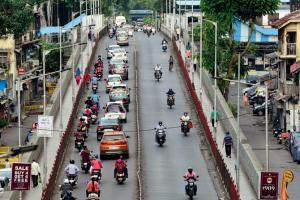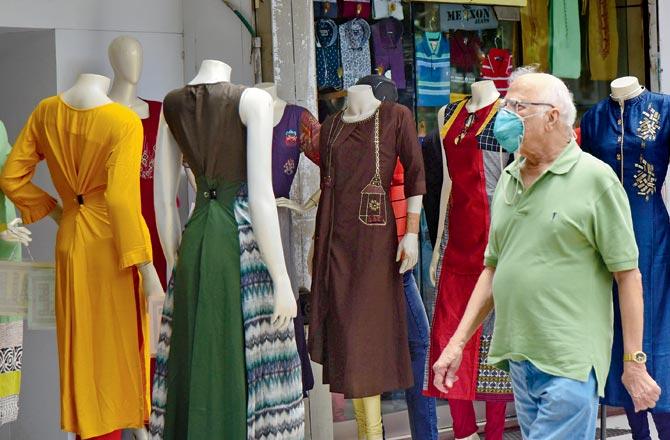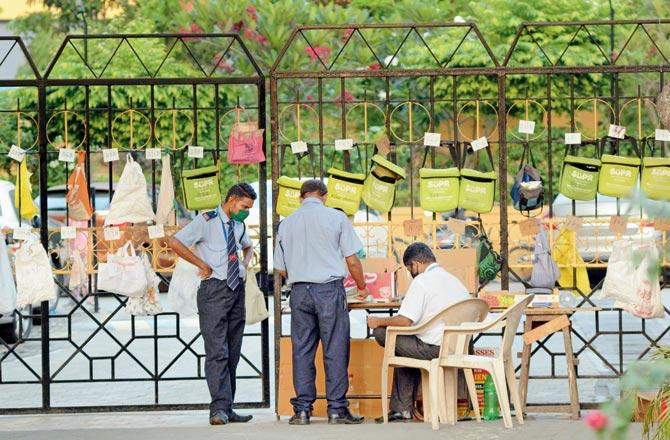Easing of restrictions has meant that social distancing is not maintained; contact tracing has become difficult as most people say they have only been to the market

Commuters seen on June 12 on Elphinstone flyover after Unlock 1.0. Movement of people across the city is making it tough for BMC to monitor infection spread. Pic/Bipin Kokate
With the lifting of some of the lockdown restrictions, the trend of COVID-19 cases in the city seems to be shifting again. While initially, the cases had first come up in residential buildings and then moved on to slums, ward officials say that over the past week, they have seen a spike in cases in housing societies again.
In L ward for instance, which has the third-highest number of cases, Assistant Municipal Commissioner Manish Valanju said, "Earlier, there were 80-100 cases from slum pockets and now there are 40-60. Over the past week, the Sangharsh Nagar area, which had no cases earlier, recorded 30 cases and HDIL (Kohinoor city), which had one or two cases, now has around 25 cases," he said.
ADVERTISEMENT
Valanju added that Sangharsh Nagar is home to people who were rehabilitated from Sanjay Gandhi National Park who primarily work as drivers and domestic helps. "After the lifting of the lockdown, people have started going out to work. We have locked down both the areas and started screening every one to control the spread. Earlier, we were only doing it on a case-to-case basis," he said, adding that in both areas only essential shops are now allowed to stay open.

Officials are also monitoring stores that have reopened amid Unlock 1.0. Pic/Suresh Karkera
The city's first COVID-19 cases had appeared mainly in residential buildings comprising people who had either travelled abroad or had come in close contact with travellers. Within a few weeks, the cases in slum areas started to rise and soon areas like Dharavi and Worli Koliwada became Containment Zones followed by all other slums in the city. However, with the easing of restrictions, social distancing norms are not being followed as strictly as earlier.
Cases double in Kandivli
In western suburbs, cases in Kandivli (R South ward) increased rapidly in June. Till May 31, there were 975 cases in Kandivli. The number doubled in the past 15 days and reached 2,007 on June 15. There are around 90 buildings in Lokhandwala, Kandivli West with more than 22,000 residents. There were 36 COVID-19 cases until the end of May. An additional 15 cases have been reported since then.
"After the government eased lockdown norms, residents also wanted all services back. In many societies, maids are allowed. Others are disputed over allowing them. Some residents go for essential services," said Raj Kashyap, founder of Lokhandwala Residents Association. He said that police are always making rounds and asking people to follow norms, but there is no major drive from R South ward. Maybe the health team works discretely, he added.

Health workers check the temperature of residents of Motilal Nagar in Goregaon West
Vijay Nagar, one of the largest societies in Andheri East recorded the last patient on June 5. There are around 500 houses with over 1,500 residents. "Even after the lockdown was eased, we restricted the opening of the complex. Out of the 22 cases reported since March, around 14 were reported in one wing from a known contact. Otherwise, the situation was under control. But today, we allowed maids. So we are keeping a close watch on the situation," said Prasad Pendse, secretary of Vijay Nagar. He added that out of 500, only 150 houses are allowed to have maids in their homes.
The ratio of cases in slums and buildings in K East ward (Jogeshwari E, Andheri E, Vile Parle E) is 50:50. "Earlier, the ratio of cases in slums and buildings was 70:30. Now the number is equal in both the areas," said Prashant Sapkale, assistant municipal commissioner of K East ward.
Sapkale said that in K East ward, there are 43,573 commercial establishments. Out of these, 21,365 are open and 1, 09,702 employees, mostly from nearby areas joined work. As per official records, there are 19,911 shops in K East ward where 24,843 people work. Out of these, 11,411 shops are open and 10,688 people, including shop owners, are working. These people are majorly from the buildings and got contracted.
Need to follow precautions
P North, another ward with a higher number of cases, saw growth in residential buildings and a drop in numbers in slum areas. Ward officials are collecting data to see which societies are getting positive cases repeatedly to plan measures. "Earlier, we were getting 35-40 cases from residential buildings, but now there are more than 75 cases possibly due to the lifting of lockdown. In slums, however, the numbers have dropped by 10 per cent. We have sent letters to the secretaries of societies to ensure that the residents follow all safety precautions," said Sanjog Kabre, assistant municipal commissioner. He added that if the number of cases continues to rise, they may have to seal the societies.

Parcels of society members in Kandivli seen on the main gate during the lockdown earlier in April. Pics/Satej Shinde
In the island city, flouting of norms prompted Makarand Dagadkhaire, assistant municipal commissioner, E ward to issue notices to several shops where people were seen crowding. "Over the past week, there has been a 30-40 per cent increase in the number of cases in residential areas of Nagpada, Mazgaon and Mumbai Central. Show cause notices have been issued to five to six shop owners wherever we felt cases were increasing and norms were not being followed," he said.
Dharavi, which comes under the G North ward, was a hotspot for COVID-19 cases, but after a major drive including screening, health camps and isolation of patients, the number of cases is under control. But in other parts of the ward, the number of cases started increasing in June. "The number of cases is increasing in buildings and chawls in Mahim and Dadar. These residents protected themselves in the lockdown. But as the norms eased, they are coming out of the protected areas and are getting infected," said Kiran Dighavkar, assistant commissioner of G North ward.
While the total number of cases in F North ward, comprising Wadala and Sion is high (more than 3,000), the number of daily cases has reduced. Earlier, on an average, 80 cases were reported per day, now the number is 30-35. "In March, cases were detected in buildings having residents with travel history. Then cases emerged in slums. The sealing of slums helped reduce cases. But on the other hand, the number of cases in buildings isn't decreasing," said Gajanan Bellale, assistant commissioner of F North ward. Bellale told mid-day that most of the time, patients said they had only been to the market. The health team hasn't found any other trace in many cases.
10
Percentage drop in new cases in slums in P North ward
Catch up on all the latest Mumbai news, crime news, current affairs, and a complete guide from food to things to do and events across Mumbai. Also download the new mid-day Android and iOS apps to get latest updates.
Mid-Day is now on Telegram. Click here to join our channel (@middayinfomedialtd) and stay updated with the latest news
 Subscribe today by clicking the link and stay updated with the latest news!" Click here!
Subscribe today by clicking the link and stay updated with the latest news!" Click here!







